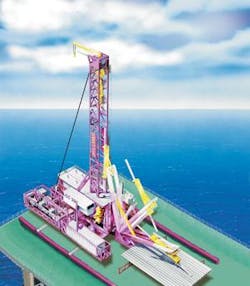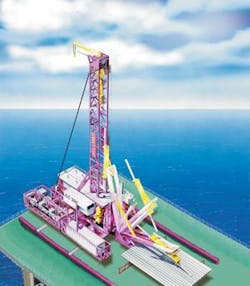Containerized rig cuts costs of casing while drilling
Casing while drilling (CWD) is designed to reduce both drilling time and unscheduled incidents that can hamper productivity. With CWD, the well is drilled with standard oilfield casing that stays in the hole and is cemented in place at the casing point.
Rotterdam-based Huisman Special Lifting Equipment has teamed up with Houston-based Drillmar to design and build a new containerized 250-ton hook load rig employing CWD technology developed by Tesco. Two land and offshore containerized rigs, designated LOC250, are under construction, with the first due to be operational in September.
The LOC 250 incorporates a substructure or skid, which can accommodate all CWD-related equipment containers except the fuel and water tanks, for deployment on fixed offshore platforms. Skid units can support the substructure, allowing an X-Y movement of the complete rig assembly.
Alternatively, the LOC250 can be reconfigured as international standard offshore (ISO) containers, allowing mobilization costs to be reduced by up to 30% in the case of a local rig move or by several hundred per cent for international shipments, the partners say.
Due to the versatility of the ISO containerized design, the partners add, the rig can be used in various modes. Offshore, the options are platform-based or on barges for drilling in lakes or swamps. Further modules can be added if necessary, such as extra mud pumps and mud tanks or increased hook-load.
In addition to casing handling, the LOC250 is also equipped to handle drill pipe for open-hole completions, setting packer, liners and screens.
The partners designed handling of casing and drill pipe to be an identical operation, allowing well construction teams to transfer learning curves from one application to the other. With CWD, a fast-acting, fully automated pipe handler upends the tubulars, which the elevators subsequently take over. The Tesco HMIS-250 top drive serves to spin in and torque up the connections. Fully automated power slips are integrated within the Huisman-supplied rotary table.
To reduce flat-time activities, the partners pressure tested offline the T3 Services BOPs on a dedicated test stump. Following testing, there is no need to disconnect the control hoses to move the BOP onto the wellhead. Bottom hole assemblies can also be made up and broken out offline, using the crown-mounted service, 6,000 kg capacity Huisman crane. The BHAs can be racked back at the side of the mast, either ready for running into the hole or broken and laid down off the critical path.
To minimize the risk of accidents during handling operations, the fully automated drillfloor (again, supplied by Huisman) and the service crane can be used to move personnel out of the danger zone. The partners also say that the LOC250 cuts hydrocarbon emissions per well by up to 7%. This is achieved through much lower standpipe pressure, which reduces the power requirement for the mud pumps; by drilling wells more quickly; and through not running the casing, tripping pipe, or transporting drillpipe to the location.•

